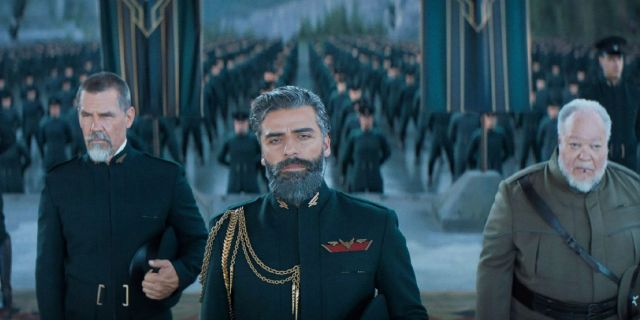The Dune universe features a complex network of organizations steeped in thousands of years of history and seemingly endless power. The mighty familial dynasties answer to the dictatorial Emperor, while more obscure organizations dominate crucial resources. The Spacing Guild trains prescient navigators to travel faster than light. The Bene Gesserit Sisterhood uses religious propaganda to influence affairs from the shadows. Each of those all-powerful groups holds a share in the galaxy’s commercial hub, CHOAM.
Denis Villeneuve’s Dune and Dune: Part Two are arguably the perfect adaptations of Frank Herbert’s supposedly unfilmable science fiction classic. The story is full of details that flesh out the living universe but don’t directly affect the narrative. Villeneuve smartly took the scissors to the novel to rid himself of the needlessly complex elements and streamline the experience without sacrificing depth. CHOAM didn’t make it into the films, but it remains a fascinating part of the franchise.
What is CHOAM?

The Combine Honnete Ober Advancer Mercantiles is a monopolistic conglomerate that controls all commerce throughout the Dune universe. All material goods flow through CHOAM. All substantial wealth comes through interests in CHOAM. The CHOAM network runs through every other seat of power. CHOAM is under the Corrino Empire, the highest station in the universe, which oversees CHOAM’s board of directors. CHOAM was a publicly traded company. Shareholder profits could make any participant fabulously wealthy. Only the noble patriarchs of the Great Houses could become shareholders in CHOAM. The Houses fought for directorship positions, seeking to earn dividends and skim profit from their impossibly vast businesses. The Emperor reserved the right to revoke or hand out director positions, giving him the final say in any profit-seeking venture. Alia Atreides outlines the tremendous influence of CHOAM with this line:
When
Idaho
said CHOAM, he spoke of a constant ferment, intrigue within intrigue, a play of powers where the shift of one duodecimal point in interest payments could change the ownership of an entire planet.
CHOAM works closely with the other organizations atop the Dune universe. Its connection to the Landsraad and Padishah Emperors is paramount, but the organization is also closely connected to the Spacing Guild. The Guild dominates faster-than-light travel. Any shipping industry requires Guild Navigators to deliver its products. This creates a mutual dependence between the two seemingly omnipotent corporate entities. The Spacing Guild needs merchandise to ferry as much as CHOAM needs ships and navigators to run them. The Bene Gesserit also works quietly with CHOAM to spread its influence. These systems maintain the flow of the spice melange, guaranteeing the supply of the galaxy’s most in-demand resource.
How did CHOAM form?
The original Dune novel never delved into the origin of CHOAM, but future Expanded Universe outings unpacked its backstory. CHOAM emerged from the same corporate background as the Spacing Guild. CHOAM was once Combined Mercantiles, a subsidiary of Venport Holdings. Venport Holdings began life as VenKee Enterprises, formed after Aurelius Venport worked with slaver Tuk Keedair to harvest spice. Aurelius was a successful businessman elevated by the chaos and innovation of the Butlerian Jihad. He developed a grotesque relationship with his adopted daughter and future wife, Norma Cenva. Norma was a scientific genius who discovered the Holtzmann Effect, allowing her to master faster-than-light travel. With Norma’s guidance, Venport Holdings devoted resources to developing the first foldspace engine. Its various subsidiaries combined to form all-powerful institutions. Venport owned the Spacing Guild and CHOAM, developing an empire of commerce beyond the wildest dreams of his competitors. Aurelius died before his empire reached its peak, leaving Norma to operate the nascent CHOAM. Princess Irulan summed up Norma’s brilliance like this:
It was said of Norma Cenva that one could not judge her on the basis of appearances. No matter her physical failings or the classic beauty that eventually replaced them, neither represented the essence of the woman. She was, above all else, a cerebral powerhouse.
CHOAM rarely appears in Dune. Characters speak about the monopoly in oblique terms. It is, however, central to one powerful moment near the end of the novel. Before the final Battle of Arrakis between Paul Muad’Dib Atreides and his Fremen worshipers and the combined forces of Emperor Corrino and House Harkonnen, Paul watches his enemy from afar. He questions which flag Emperor Corrino will raise over his new base. If he lifts the flag of House Atreides, he indicates surrender. If he flies House Harkonnen’s banner, he demonstrates his intention to fight. Emperor Corrino raises the yellow flag of CHOAM. With that action, he admits that the sheer power of overwhelming wealth should triumph over any political concern. Beyond honor, vengeance, or even generations of messianic prophecy, CHOAM demonstrates that money reigns supreme. Though they don’t do a lot in Dune, their presence tells a compelling story.











Leave a Reply